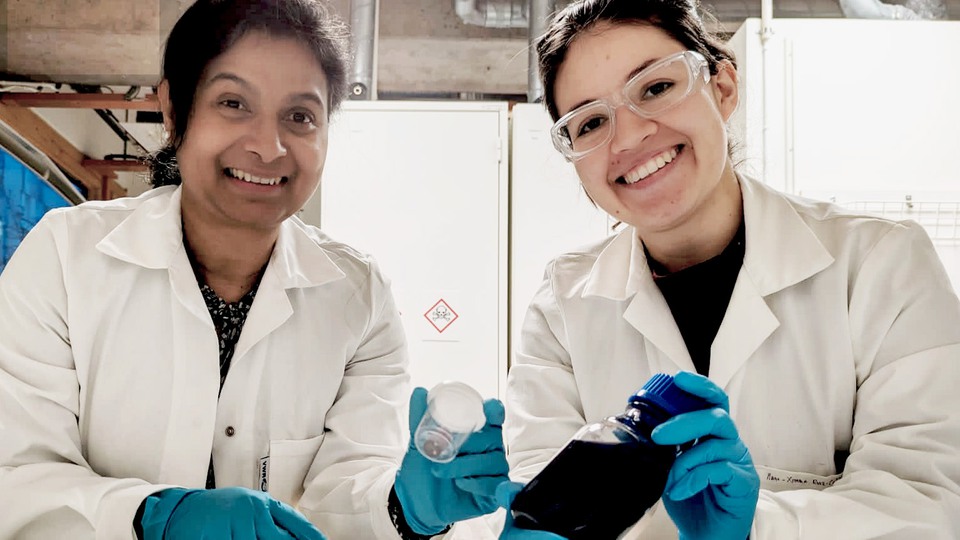
Aji Mathew (left) works with PhD student Maria-Ximena Ruiz-Caldas and others on developing sustainable processes for recycling post-consumer textiles.
Aji Mathew and her team are finding processes to upcycle used textiles
Professor Aji Mathew and her research group at Stockholm University are finding solutions to upcycle used textiles of both cotton and synthetic fibres.
The textile industry has a very high environmental impact. As much as 63 percent of all textiles are made of fossil-based resources with high climate impact. 30 percent comes from cotton cultivation associated with water depletion, intensive use of pesticides and fertilizers and toxic air and water pollution during industrial processing.
Upcycling into nanocellulose
This research focuses on the upcycling of cotton in post-consumer textiles into high-value products such as nanocellulose. The processes also allow the recovery and use of non-cellulosic parts of the textiles.
How does this research contribute to the Mistra SafeChem vision of a safe, sustainable and green chemical industry?
– We look for solutions to upcycle and ”cascade use” textile waste into valuable additives and materials following the principles of green chemistry. The use of water-based reactions and the reduction of waste are some of the key guiding principles. We also contribute to sustainability by evaluating the chemical fate during the recycling process and finding solutions to improve the processes to decrease the chemical and carbon footprint, Aji Mathew says.
What are the results?
– We have successfully developed water-based processes using mineral acid and organic acids to convert cotton-based textiles into nanocellulose and recover non-cellulosic polymers such as polyester, acrylics, elastane etc. The nanocellulose from textiles showed similar properties as conventional nanocellulose but also has colour originating from the dyes in the starting material.
The project has contributed to a startup, CelluCircle AB, which can produce 3D printable materials from recycled cellulose.
Contributions by many groups within Mistra SafeChem
The results are common progress for Mistra SafeChem, as several research groups have contributed.
The analytical chemistry team performed non-targeted screening of the nanocellulose and the process water which provided new insight into the fate of chemicals as dyes during the process.
The LCA team at RISE has evaluated the environmental footprint by an attributional screening and mapping analysis of cellulose nanocrystal preparation at a laboratory scale.
– The life cycle assessment showed that post-consumer cotton could be a promising feedstock for the extraction of nanocellulose since its environmental burden is lower than that of using wood pulp, says Anna-Karin Hellström at RISE.
Can you compare the results with any other process?
– The nanocellulose prepared using organic acid was compared to nanocellulose prepared using mineral acid. Although the nanocellulose prepared using organic acid initially had higher environmental impacts, the high yield and the properties of the nanocellulose encourage the development of more efficient routes for the recovery of organic acid. The current 58 percent recovery of the organic acid by simple evaporation and crystallization reduces their environmental impact and sets the foundation for a more environmentally friendly process that can be further improved, Anna-Karin Hellström declares.
Need to evaluate scalability and footprint
Further research needed is to find a road map for utilizing the additives and polymers recovered from post-consumer textiles in high-value products and applications. The scalability of the developed processes needs to be evaluated, as well as the chemical and carbon footprint during upcycling and cascading use to ensure that the proposed road map is sustainable and safe.
Learn more
Read the article in Journal of Materials Chemistry A: Citrated cellulose nanocrystals from post-consumer cotton textiles External link, opens in new window.
External link, opens in new window.
Read about the work of Aji Mathew and others in the Mistra SafeChem annual report for 2022 Pdf, 8.1 MB.
Pdf, 8.1 MB.
-
2024-06-28 | newsImpressive achievements of Mistra SafeChem in phase 1
-
2024-06-19 | newsNew report: Crystal Engineering for Water Treatment
-
2024-05-17 | newsSee the full agenda for our final webinar
-
2024-05-15 | newsThe Mistra SafeChem in silico toolbox presented at the SETAC conference
-
2024-04-03 | newsFour more years – Mistra SafeChem gets go-ahead for second phase

